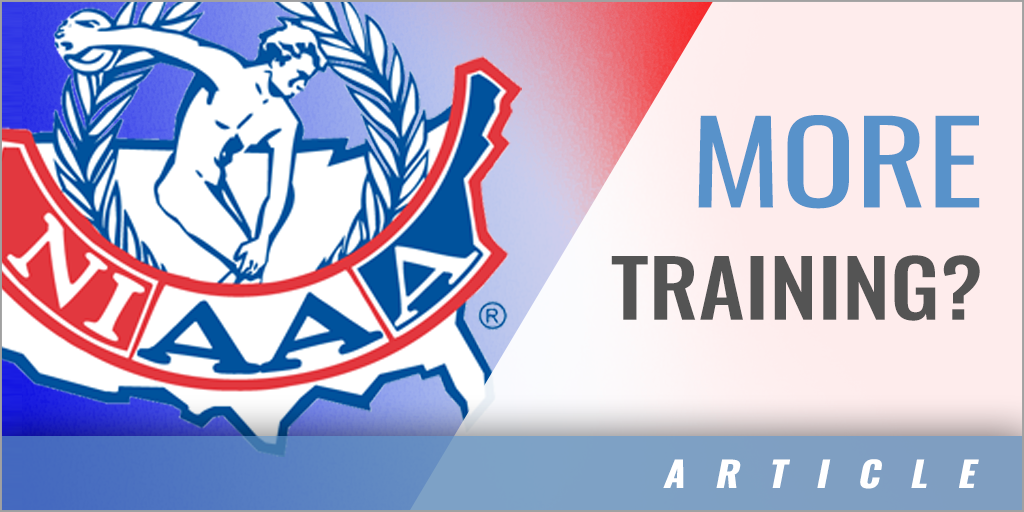|
By: Steve Bridge, CMAA - Washington Several coaches in the State of Washington are probably asking themselves this very question as the WIAA has put in place further training mandates for all football coaches. Before football starts this fall, coaches will have to have training in the following; 23.3.1 F - All Middle School and High School football coaches must complete school district approved technique specific safety training similar to "Heads Up Football". The training must include but is not limited to Safer Tackling Techniques and Drills, Helmet and Shoulder Pad fitting, Concussion management with Return to Play Protocols following a concussion, Head and Hydration training and Sudden Cardiac Arrest training. Football coaches will be required to repeat this training every three years. So, why the need for more training? This article will attempt to answer this question and even though some may not agree, the truth of the matter is we all have a responsibility to provide the safest environment we can for our student athletes. With football, the issue of safety has reached a critical pinnacle. During the USA Football conference in Indianapolis this past February, one of the presenters discussed statistics from the National Federal of High Schools (NFHS) regarding athletic participation. The results were during the 2014-15 school year, participation among high school students in interscholastic athletics had reached an all time high, sparked by the increasing number of female athletes in sports like soccer and basketball. But two very significant numbers were also shared and those were the declining participation in two programs, football and wrestling. Participation in football during the past school year was down nearly 10,000 students and wrestling was just over 11,000. There are probably several reasons for the decline but the one factor we can all agree on is the safety concern, especially regarding football. How can additional training be effective in providing a safety element? The State of Washington became the leader regarding concussion training and awareness and in November of 2014, Mississippi became the 50th state to mandate concussion training to their coaches. Through the Seattle Sports Concussion Center and the work of people like Dr. Stan Herring and the Lystedt family, as well as efforts of the WIAA, better training and communication between parents, players, coaches and the medical community will be available to further address the issue of concussions. The concussion issue leads directly into needed training for helmets and pad fitting. Several articles are available relating the increase likelihood of concussions from ill fitting helmets. Coaches need to ask themselves, “Are we providing the best affordable and safest equipment possible to our student athletes and if we are, do coaches know how to fit the variety of helmets available. Another fact is not all helmets models fit the same. This is why we encourage schools to have a variety of helmets on hand simply because some helmets fit some kids better than others. Each make of helmet may not have the same fit and as a result proper fitting procedures provide the best practice regarding safety for our student athletes. How each school and coach decides to address this issue is an individual decision. USA Football does an outstanding job addressing this topic and different helmet companies provide video’s on proper fitting procedures. Over the past few years, Clear Risk Solutions has conducted workshops in the Tri Cities area brining in certified athletic equipment managers from Eastern Washington University and University of Idaho who have expertise in fitting all helmets as well as providing valuable information on the care and proper inventorying of equipment. This has proven to be a great training opportunity for those attending. The safe tackling technique training is important as the intent of “taking the head out of the game” sometimes takes a change in culture. The “old school concept” of encouraging collisions or high impact simply needs to be reviewed and we know that without training or better information that helps promote change, we will continue to do things as we were coached and how we learned. There is simply too much information out there for coaches to not adjust how much contact players need to have during the season as well as looking for better ways to avoid initial contact with the head. The “Rugby Style or Seahawk Tackling method has been proven to assist players to lead with the shoulder and to follow through with the hips and the thighs and have the strength core of the body take the majority of the initial impact. An estimated 78% of football plays end with a tackle. It is best we teach players the safest and most effective way to complete this task. Finally, the issues of Heat and Hydration and Sudden Cardiac Arrest are also valuable parts of this training. Again, from the USA Football Conference, Dr. David Casa from the University of Connecticut and the Cory Springer Institute shares some statistics. In 2015, there were 17 football related deaths. 7 were from what is termed a “Direct” causes and 10 from “Indirect” causes. A direct cause is a head or spinal cord injury and an indirect cause is from everything else. Of the 10 Indirect causes, 6 were from Cardiac Issues, 3 from Heat and Hydration related issues and 1 from an illness. Further statistics share that from 2000 to 2015, there have been 149 football related deaths in college and high school football. 41 of these were from direct causes while 108 were from indirect causes. The most significant factor with the indirect numbers is these are nearly all preventable if proper information and training is applied. We know that deaths related to indirect causes usually occur during the first three days of practice and during conditioning. Simply being more aware of a heat acclimation process during the first few days may reduce the majority of indirect issues. Another factor is the use of an AED if a cardiac emergency were to take place during practice or a game. Just the fact that some schools have trainers does not reduce responsibility from the coaching staff. The majority of schools in the State of Washington DO NOT have trainers and even the ones that do may not have access to trainers all the time. Current first aid does provide training on the use of AED machines but who has the responsibility to make sure everyone knows where they are, have access to them and if they are in proper working condition. Just these two issues alone will have an impact of the two most significant causes of death in athletics. Over 70% of cardiac related deaths occur during football and basketball. Of the remaining 30% nearly 3/4 are soccer related. If a student were to collapse, the survival rate is reduced by 10% with each minute the student is left untreated. If treated within the first minute, the survival rate is 90%. . Again, training and awareness are crucial to provide a “best practice” approach to safety for our players. It is also important for coaches to be part of an emergency action plan. Though this may not be a coach’s primary responsibility, it is important coaches are aware of the plan and are part of the formation and line of communication. No one knows your facility better than the coach and he/she can play a vital role in assisting medical personnel to reach an impacted student athlete. Again, I want to thank the WIAA and the Washington State Football Coaches Association for their support and determination for preserving the game of football. No other sport activity provides the needed lessons young people will use to be productive members in our society than those taught by responsible, well trained coaches. Have a great and safe season. |







